Abstract
Twenty four hour oesophageal intraluminal pH probe studies were performed in 114 children (range age: one month-12 years) referred for symptoms or signs compatible with gastroesophageal reflux. Forty five patients had reflux disease alone, 69 had evidence of oesophagitis which was assessed endoscopically and histologically. Recordings were also performed in 63 control patients. The occurrence of reflux was analysed for the total study period and particularly while awake, asleep, fasting, and during postcibal periods. Oesophageal acid exposure time and the number of reflux episodes lasting greater than five minutes during the total study period provided the best discrimination between patients and controls; however, 20% and 30% of all reflux patients had both normal (with 2 SD of control) acid exposure time and number of long lasting reflux episodes, respectively. Patients with oesophagitis had significantly more acid reflux than those with simple uncomplicated disease during postcibal, fasting, awake periods, but not during sleep; however, increasing severity of oesophagitis was not associated with increasing acid exposure. The ability of the intraluminal oesophageal pH test to discriminate patients with various degrees of reflux disease decreased if only postprandial pH variables were taken into account. We conclude that: (1) the 24 hour intraoesophageal pH monitoring may present false negative results that limit overall sensitivity of the test; (2) the presence of oesophagitis does not seem to be associated with increased oesophageal acid exposure during sleep; (3) limiting the pH recording to postprandial periods reduces the discriminatory power of the test.
Full text
PDF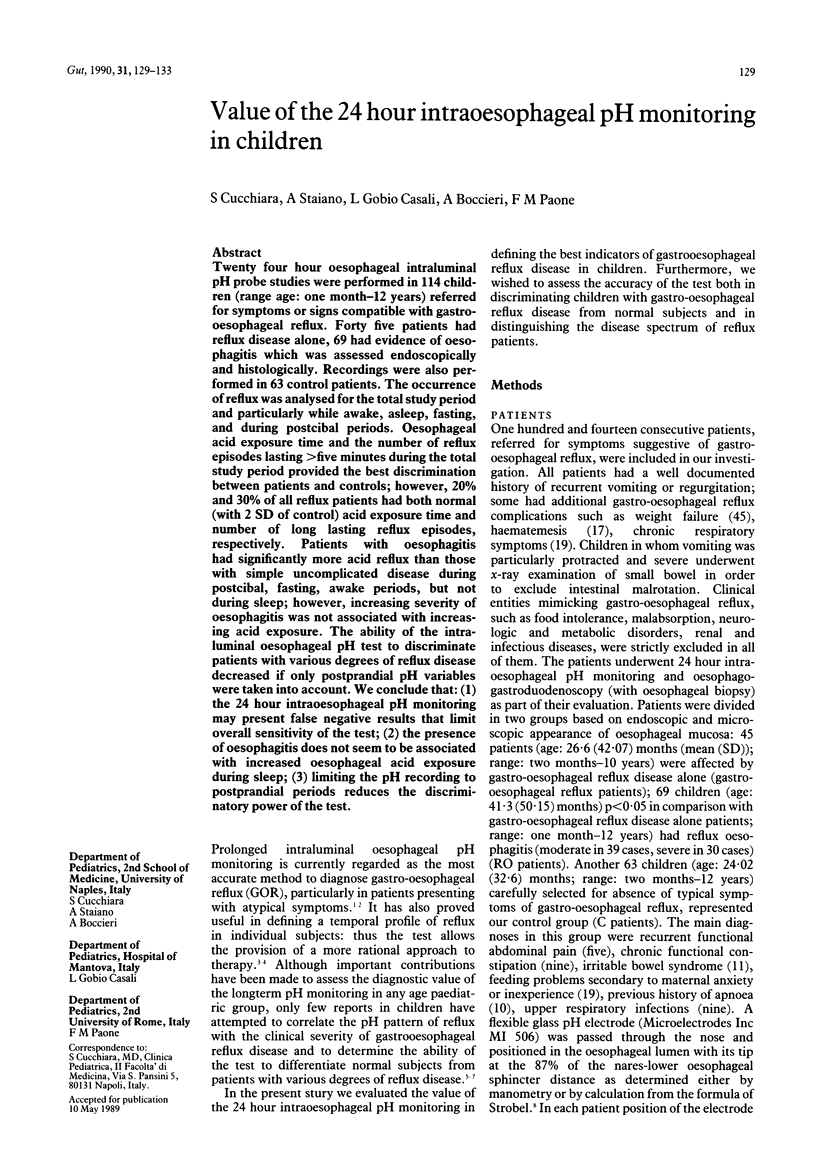
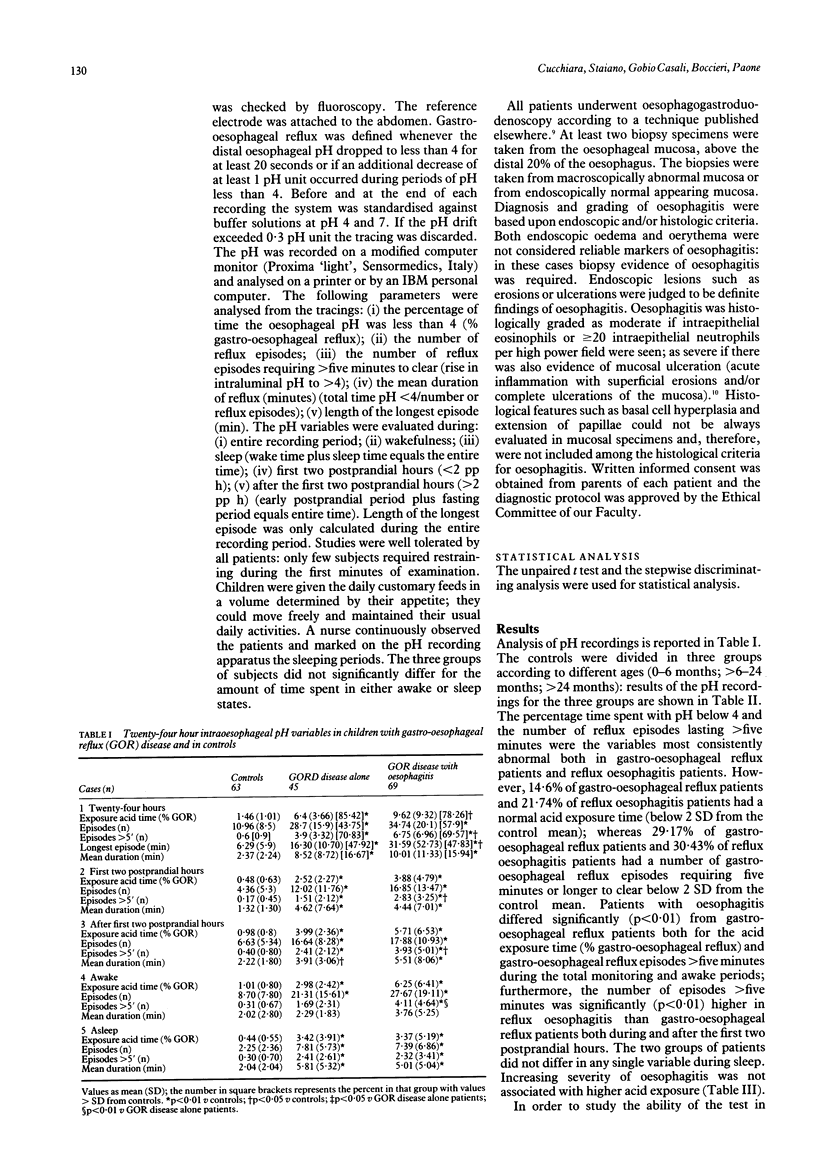
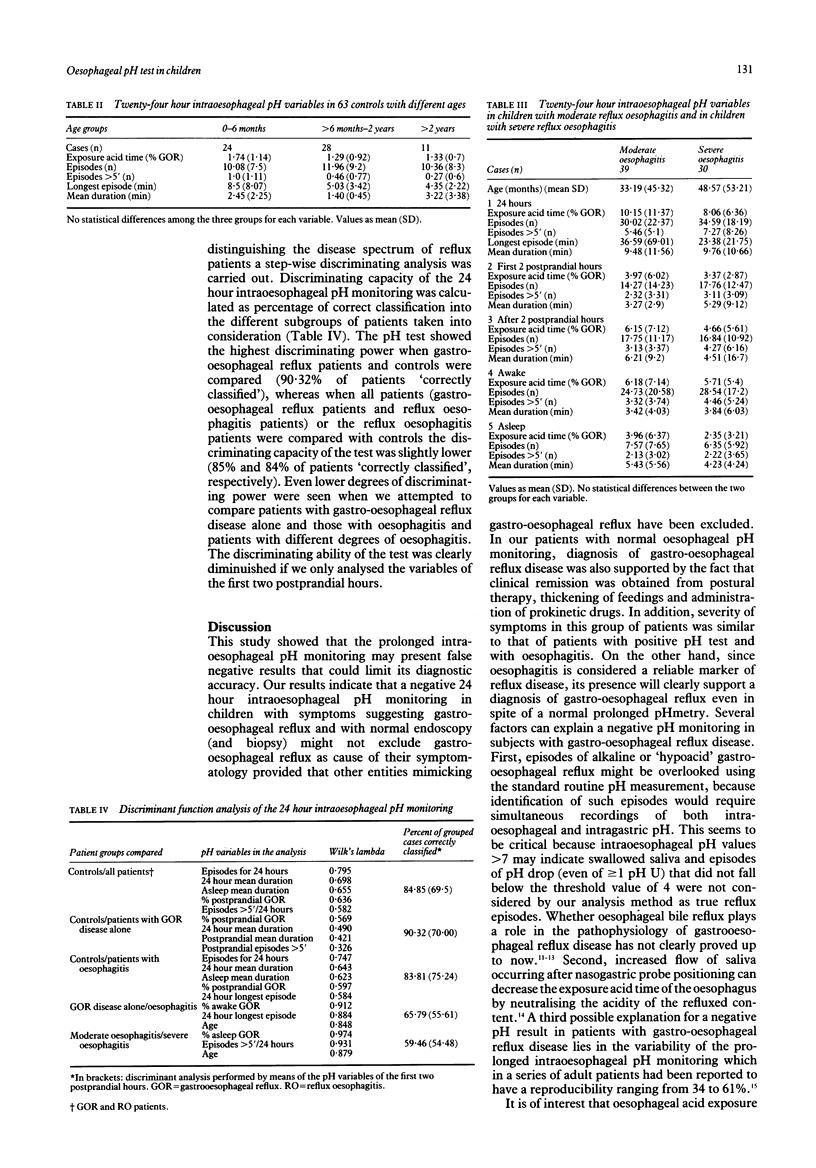
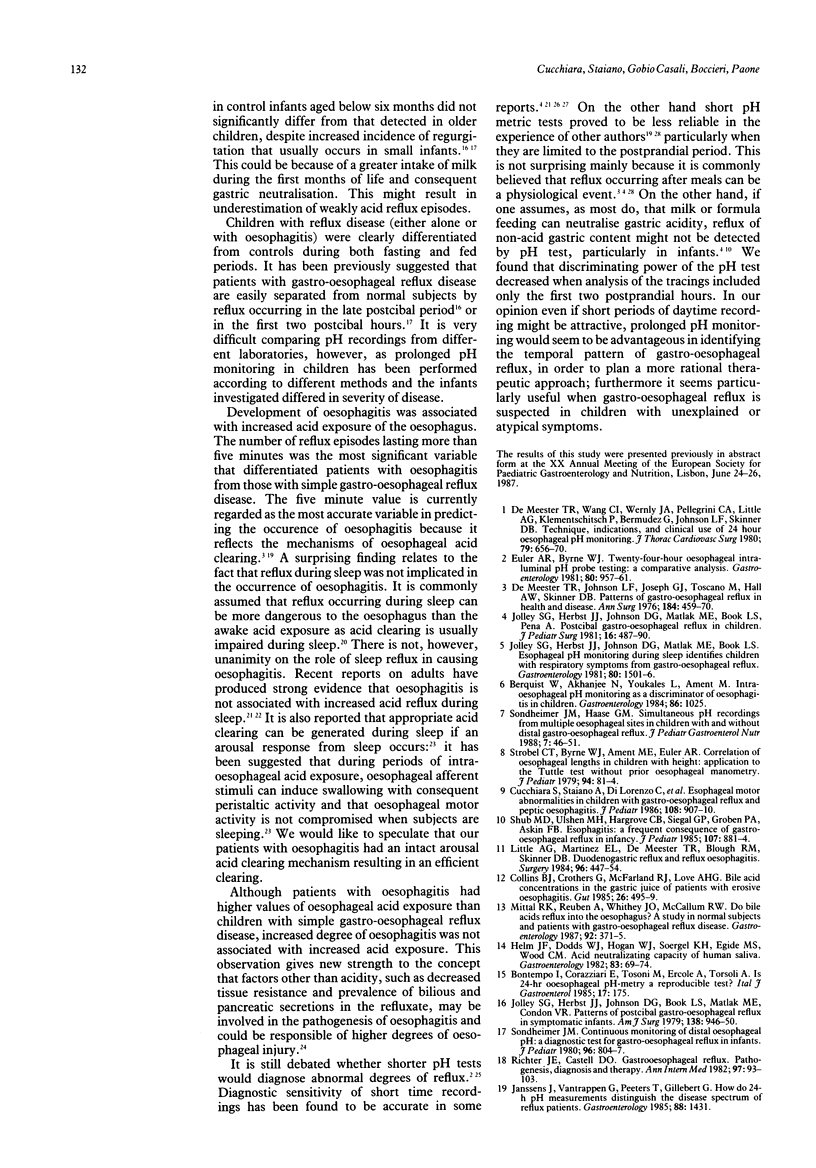
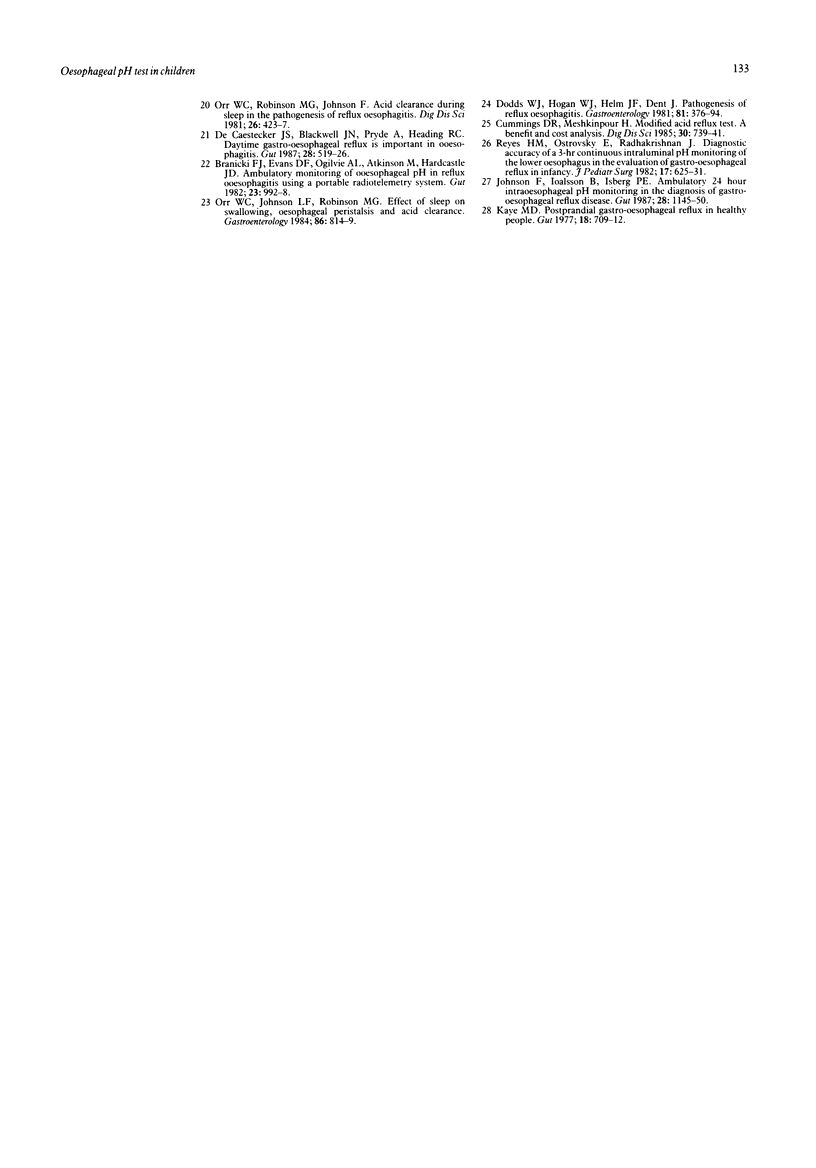
Selected References
These references are in PubMed. This may not be the complete list of references from this article.
- Branicki F. J., Evans D. F., Ogilvie A. L., Atkinson M., Hardcastle J. D. Ambulatory monitoring of oesophageal pH in reflux oesophagitis using a portable radiotelemetry system. Gut. 1982 Nov;23(11):992–998. doi: 10.1136/gut.23.11.992. [DOI] [PMC free article] [PubMed] [Google Scholar]
- Collins B. J., Crothers G., McFarland R. J., Love A. H. Bile acid concentrations in the gastric juice of patients with erosive oesophagitis. Gut. 1985 May;26(5):495–499. doi: 10.1136/gut.26.5.495. [DOI] [PMC free article] [PubMed] [Google Scholar]
- Cucchiara S., Staiano A., Di Lorenzo C., D'Ambrosio R., Andreotti M. R., Prato M., De Filippo P., Auricchio S. Esophageal motor abnormalities in children with gastroesophageal reflux and peptic esophagitis. J Pediatr. 1986 Jun;108(6):907–910. doi: 10.1016/s0022-3476(86)80925-8. [DOI] [PubMed] [Google Scholar]
- Cummings D. R., Meshkinpour H. Modified acid reflux test. A benefit and cost analysis. Dig Dis Sci. 1985 Aug;30(8):739–741. doi: 10.1007/BF01320487. [DOI] [PubMed] [Google Scholar]
- DeMeester T. R., Wang C. I., Wernly J. A., Pellegrini C. A., Little A. G., Klementschitsch P., Bermudez G., Johnson L. F., Skinner D. B. Technique, indications, and clinical use of 24 hour esophageal pH monitoring. J Thorac Cardiovasc Surg. 1980 May;79(5):656–670. [PubMed] [Google Scholar]
- Demeester T. R., Johnson L. F., Joseph G. J., Toscano M. S., Hall A. W., Skinner D. B. Patterns of gastroesophageal reflux in health and disease. Ann Surg. 1976 Oct;184(4):459–470. doi: 10.1097/00000658-197610000-00009. [DOI] [PMC free article] [PubMed] [Google Scholar]
- Dodds W. J., Hogan W. J., Helm J. F., Dent J. Pathogenesis of reflux esophagitis. Gastroenterology. 1981 Aug;81(2):376–394. [PubMed] [Google Scholar]
- Euler A. R., Byrne W. J. Twenty-four-hour esophageal intraluminal pH probe testing: a comparative analysis. Gastroenterology. 1981 May;80(5 Pt 1):957–961. [PubMed] [Google Scholar]
- Helm J. F., Dodds W. J., Hogan W. J., Soergel K. H., Egide M. S., Wood C. M. Acid neutralizing capacity of human saliva. Gastroenterology. 1982 Jul;83(1 Pt 1):69–74. [PubMed] [Google Scholar]
- Johnsson F., Joelsson B., Isberg P. E. Ambulatory 24 hour intraesophageal pH-monitoring in the diagnosis of gastroesophageal reflux disease. Gut. 1987 Sep;28(9):1145–1150. doi: 10.1136/gut.28.9.1145. [DOI] [PMC free article] [PubMed] [Google Scholar]
- Jolley S. G., Herbst J. J., Johnson D. G., Book L. S., Matlak M. E., Condon V. R. Patterns of postcibal gastroesophageal reflux in symptomatic infants. Am J Surg. 1979 Dec;138(6):946–950. doi: 10.1016/0002-9610(79)90327-1. [DOI] [PubMed] [Google Scholar]
- Jolley S. G., Herbst J. J., Johnson D. G., Matlak M. E., Book L. S. Esophageal pH monitoring during sleep identifies children with respiratory symptoms from gastroesophageal reflux. Gastroenterology. 1981 Jun;80(6):1501–1506. [PubMed] [Google Scholar]
- Jolley S. G., Herbst J. J., Johnson D. G., Matlak M. E., Book L. S., Pena A. Postcibal gastroesophageal reflux in children. J Pediatr Surg. 1981 Aug;16(4):487–490. doi: 10.1016/s0022-3468(81)80012-7. [DOI] [PubMed] [Google Scholar]
- Kaye M. D. Postprandial gastro-oesophageal reflux in healthy people. Gut. 1977 Sep;18(9):709–712. doi: 10.1136/gut.18.9.709. [DOI] [PMC free article] [PubMed] [Google Scholar]
- Little A. G., Martinez E. I., DeMeester T. R., Blough R. M., Skinner D. B. Duodenogastric reflux and reflux esophagitis. Surgery. 1984 Aug;96(2):447–454. [PubMed] [Google Scholar]
- Mittal R. K., Reuben A., Whitney J. O., McCallum R. W. Do bile acids reflux into the esophagus? A study in normal subjects and patients with gastroesophageal reflux disease. Gastroenterology. 1987 Feb;92(2):371–375. doi: 10.1016/0016-5085(87)90130-2. [DOI] [PubMed] [Google Scholar]
- Orr W. C., Johnson L. F., Robinson M. G. Effect of sleep on swallowing, esophageal peristalsis, and acid clearance. Gastroenterology. 1984 May;86(5 Pt 1):814–819. [PubMed] [Google Scholar]
- Orr W. C., Robinson M. G., Johnson L. F. Acid clearance during sleep in the pathogenesis of reflux esophagitis. Dig Dis Sci. 1981 May;26(5):423–427. doi: 10.1007/BF01313584. [DOI] [PubMed] [Google Scholar]
- Reyes H. M., Ostrovsky E., Radhakrishnan J. Diagnostic accuracy of a 3-hr continuous intraluminal pH monitoring of the lower esophagus in the evaluation of gastro-esophageal reflux in infancy. J Pediatr Surg. 1982 Oct;17(5):625–631. doi: 10.1016/s0022-3468(82)80123-1. [DOI] [PubMed] [Google Scholar]
- Richter J. E., Castell D. O. Gastroesophageal reflux. Pathogenesis, diagnosis, and therapy. Ann Intern Med. 1982 Jul;97(1):93–103. doi: 10.7326/0003-4819-97-1-93. [DOI] [PubMed] [Google Scholar]
- Shub M. D., Ulshen M. H., Hargrove C. B., Siegal G. P., Groben P. A., Askin F. B. Esophagitis: a frequent consequence of gastroesophageal reflux in infancy. J Pediatr. 1985 Dec;107(6):881–884. doi: 10.1016/s0022-3476(85)80180-3. [DOI] [PubMed] [Google Scholar]
- Sondheimer J. M. Continuous monitoring of distal esophageal pH: a diagnostic test for gastroesophageal reflux in infants. J Pediatr. 1980 May;96(5):804–807. doi: 10.1016/s0022-3476(80)80546-4. [DOI] [PubMed] [Google Scholar]
- Sondheimer J. M., Haase G. M. Simultaneous pH recordings from multiple esophageal sites in children with and without distal gastroesophageal reflux. J Pediatr Gastroenterol Nutr. 1988 Jan-Feb;7(1):46–51. doi: 10.1097/00005176-198801000-00010. [DOI] [PubMed] [Google Scholar]
- de Caestecker J. S., Blackwell J. N., Pryde A., Heading R. C. Daytime gastro-oesophageal reflux is important in oesophagitis. Gut. 1987 May;28(5):519–526. doi: 10.1136/gut.28.5.519. [DOI] [PMC free article] [PubMed] [Google Scholar]


